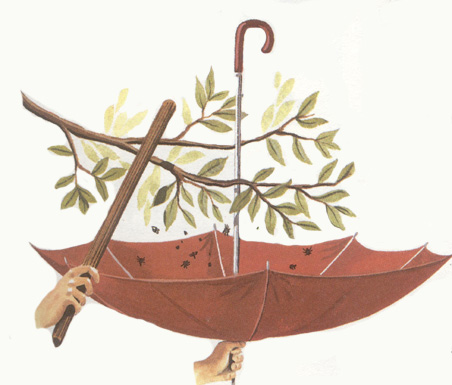

| Can you imagine 500,000 different shapes and kinds of beetles? God did. He has a great imagination! |
 Until
you have beat up some trees in search of things you never could see
otherwise, you have not lived. With a simple umbrella and a little stick
you can find thousands of insects that are watching you as you go on your
walk. Until
you have beat up some trees in search of things you never could see
otherwise, you have not lived. With a simple umbrella and a little stick
you can find thousands of insects that are watching you as you go on your
walk. |
| You can find some very interesting creatures hiding under rocks or under the bark of a dead tree. |
| With an insect net, you can easily catch most flying insects. |
| Try looking at them through a magnifying glass or a microscope. You will find lots of interesting details that you had not seen before. |
| Try looking on top of flowers. There will often be insects gathering nectar or pollen. If you look carefully, you might also see a spider or even another type of insect that is hiding in the flower waiting for another insect to land so they can eat the other insect! |
| Lots of insects live in the water. To study them, you can either watch them in the water, or try to catch them. You can look into the water with a diving mask or an open box with a piece of glass at one end. |
| If you want to catch water insects, you will want a water net. Another way you can see many insects is to pull some of the plants growing in the water and look on them. |
| Once you are through looking at the insects, you may want to collect some of them. |
| Many insects may be collected simply by putting them in a small jar or envelope and then putting it in the freezer. It will simply die. You will want to keep some information with each specimen that you decide to keep. You will need the date that you collected it, the place it was collected - including the county, state and country, and your name. If you have access to GPS, store the latitude and longitude as well. |
| The easiest was to study your insects is to mount them. Larger insects usually should be pinned. (An exception to this is dragonflies and damselflies, which should be stored in envelopes with their wings folded.) Special pins are made for insect collecting. You can find them and many other types of collecting supplies at www.Bioquip.com. |
| Once you have them mounted, you will need to store them safely. Bioquip has some special types of storage. However, to get started, you can easily store them in cigar boxes or the type of plastic containers made for sheet cakes. Just glue some cork or Styrofoam in the bottom to stick the pins in. You will need to store the cigar boxes in an airtight container of some type. Keep some mothballs or a piece of No Pest Strip in your collection. Otherwise, you will get a little beetle in your collection that will eat your specimens. |
Written by Ron McCluskey